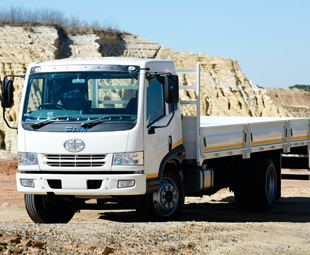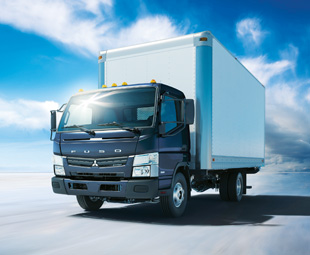For the love of all things heavy

The heavy commercial vehicle (HCV) sector forms an integral part of the South African trucking industry. Are the struggling rand and low consumer confidence affecting this sector? CLAIRE RENCKEN takes a closer look.
In general the economy remains in a depressed state, which naturally affects all businesses. Kobus van Zyl, executive director: Daimler Trucks & Buses Southern Africa, explains: “The HCV market has declined by around four percent in the first half of 2016, and this is because of a number of factors.
“These include the current economic conditions in which we find ourselves, where we are experiencing subdued economic activity and continued price hikes. However, we have amassed a considerable amount of experience in the segments in which we operate, and this is evident in the number of customers we continue to serve. We have noticed that during such tough times people opt for brands that they trust, such as Daimler Trucks & Buses, as well as Mercedes-Benz Vans.”
So, all is not doom and gloom in the HCV industry. In fact, for some original equipment manufacturers, things are actually looking positive. FAW’s marketing and strategy department manager, Cheng Zhang, comments: “The June National Association of Automobile Manufacturers of South Africa (Naamsa) sales reports show that the HCV segment is showing 2,4-percent growth month on month.”
Leslie Long, senior manager: marketing and demand planning at Hino SA, adds: “The HCV segment has shown uncommon resilience in light of the prevailing economic conditions this year – during the first six months, HCV sales were less than a percent down on last year, versus -19 percent in medium commercial vehicles and -6,7 percent in extra-heavy commercial vehicles. On closer inspection this is as a result of strong growth from lower-cost brands especially in the construction segment (tippers and mixers). The segment leaders have all shown a bigger than segment decline in sales.”
 Zhang goes on to say: “HCV fleet owners operating in certain transport sectors are holding steady economically. These sectors seem to include construction, long haul, agriculture and distribution.
Zhang goes on to say: “HCV fleet owners operating in certain transport sectors are holding steady economically. These sectors seem to include construction, long haul, agriculture and distribution.
“In our experience, in this competitive climate, some fleet owners are acquiring additional stock to improve fleet flexibility in order to honour their own 100-percent uptime commitments. This way they increase their reputation for on-time delivery. We may even be seeing a slight growth in start-up businesses and expanding opportunities for smaller fleet owners,” he adds.
Interestingly, FAW has seen its largest success to date in the last six months, nearly doubling its sales over the same period last year. Zhang believes this surge can be attributed to a variety of reasons.
“First and foremost is the huge trust customers have, and continue to place on the FAW 15.180FL model. This model has exceeded its reputation for optimal operating cost efficiencies, affordability, reliability and uptime,” he explains.
“It is also a highly flexible vehicle, which is easily combined with virtually any body requirement, from drop side to box bodies and tautliners. It is especially prevalent in the fast-moving consumer goods fleets. We are reviewing extending this particular favourite chassis-cab truck to other applications.”
Another reason for the overall growth of the FAW brand in sub-Saharan Africa is the fact that it builds locally in South Africa, for Africa, at its Coega plant, which was established two years ago. This reduces time-to-market on orders and has resulted in increased parts supply and a growing African footprint.
“Year on year, so far, we have moved up two positions overall in the total commercial vehicle market, despite little to no representation in the medium commercial vehicle and bus segments,” adds Zhang.
“All things being equal, we believe that the current market trends will remain largely the same for the remainder of this year. Our forecasting and analyses indicate that 2017 may show a slight improvement on this and last year’s overall sales.
“Obviously, in an interconnected global environment and dealing with many foreign economies, various issues will continue to impact us in a number of ways – mainly oil prices, exchange rates, labour costs and a stable supply chain. Nonetheless, we think that the HCV segment in Africa appears to be where much of the future business, and thus new fleet owners, will be positioned for vehicle purchases,” he says.
Van Zyl also remains positive about the future: “We are confident that there will be an upturn in our economy, and this will spark a positive trend leading to more orders of heavy commercial vehicles.
“We continue to keep a close eye on key economic indicators, and are optimistic that when the opportunities present themselves, we will be ready with the most ideal products and services. Our Daimler India Commercial Vehicles plant in Chennai continues to manufacture world-class vehicles that are tailor-made for the southern African market.”
Long concludes: “We have seen a ‘wait and see’ attitude from customers to counter the economic slowdown, while the banks have all toughened up on approval criteria to manage risk. Having said that, the HCV segment will recover into the future in line with economic cycles, as HCVs form an integral part of any transport solution, and, as we all know, the economic activities in the country are, literally, driven by trucks.”
Published by
Focus on Transport
focusmagsa




